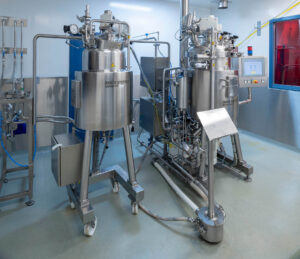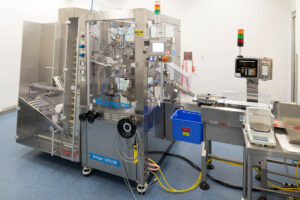Pharmaceuticals
Topical drug formulation: the challenges and new solutions 17th August 2020
By Dr Ralph Landau, Head of Development, Cambrex

Drug product formulation is a complex endeavour and every formulation presents unique development and manufacturing challenges that will vary based on the type of drug and the method of administration. Here, the particular challenges facing formulators of topical drugs are discussed and ways of addressing these are presented.
Topical drugs are prescription or over-the-counter (OTC) dermatological drugs or pain medicines that are manufactured as lotions, creams, foams, solutions, suspensions or gels. They are classed as a semi-solid drug product based on their composition of water, oil, the active pharmaceutical ingredient (API) and other ingredients such as thickening or gelling agents, emulsifiers, preservatives, antioxidants and solvents. This type of formulation is particularly challenging because it requires specific consistency and stability, and aligning the mechanism of action and sensory characteristics can be challenging. In addition, like liquid formulations, topical drugs are typically less stable and have a shorter shelf life than solid dosage forms.
The mechanism of action pertains to the intended use of the topical, and whether it is meant to treat the surface of the skin by penetrating to a certain layer of the dermis, or into muscle tissues, as with pain-relieving drugs. A topical should be easy to apply and have a composition appropriate to the needs of the product. From a sensory perspective, a topical should have a good texture (also known as skin feel), appearance and smell that should not change during the documented shelf life of the product.
Getting into the skin
Topical formulations can be applied to treat a range of dermatological indications including dermatitis, eczema, pain, psoriasis, antimicrobial treatment/infection, diabetic ulcers and acne.
In addition to an appropriate composition and texture, a topical should be easy to apply and not cause irritation. While this may sound simple, it requires a concentrated development work focused on five key physical characteristics:
- Homogeneity
- Particle distribution
- Grittiness
- Spreadability (ease of application vs tendency to drip)
- Need for surfactants
The viscosity of a topical has a strong impact on skin feel and will help to determine how a topical is classified, in addition to all five of the key physical characteristics listed. Ointments are made without an aqueous phase and have the thickest feel of all the topical drug types. Gels are made without an organic phase and tend to have the lightest feel. Creams and lotions are emulsions, the only real difference between them being their viscosity, creams being thicker than lotions.
The choice between formulating a product as an ointment, lotion, cream or gel is driven by the indication, including what area of the body is being treated and the frequency of application. It can also be driven by market forces. For example, just as a tablet is not considered equivalent to a capsule, the various types of topical dosages are also considered to be different from each other, which means a generic of ‘Brand A’s’ lotion could not fill a prescription for ‘Brand A’s’ cream. Therefore many companies will introduce topical line extensions in a new topical dosage form in order to remain exclusive. Determining whether the API needs to act on the skin surface or whether it should be absorbed into the skin is critical in the choice of formulation as there are ingredients that encourage or discourage penetration.
Quality process for quality products
Drug product formulation success relies on batch-to-batch consistency and the reliability of the process and of the product. Somewhat unique to topical drugs is the property of viscosity. Many processing factors can affect the final viscosity, including mixing speed and duration as well as small changes in composition, particularly of thickening agents. Viscosity is a critical variable to control in topicals because it is related to drug delivery rate.
When manufacturing bulk powder for tablets or capsules, the time of mixing (for example in a V-blender) has very little impact if the mixing is continued an extra hour after homogeneity is achieved. However, semi-solids can experience significant viscosity changes (shear-thinning or shear thickening phenomena) if process variables are not tightly controlled. Whether working with prescription topical drugs or OTC products, there is a need to achieve the exact same texture, viscosity and homogeneity across batches. This not only affects the clinical performance of products, but also affects the patient experience when the patient applies the topical. Products with variable viscosity tend to receive more customer complaints.
Even the smallest of details can impact the critical quality attributes for topical products, highlighting the importance of documentation and managing the process closely from the start. Material sourcing will have just as much impact as working with the right equipment and testing methods.
Topical formulation technicalities
Successful process design requires extensive analysis and preparation prior to implementation. Important variables in topical formulation will require experimentation and innovative solutions. Some of the most crucial elements to consider are:
- Identifying/profiling the API
- Optimal concentration of viscosity agents
- Degradation of APIs depending on formulation composition
- Appropriate filler and preservative ingredients
- Sterile filtration requirements (for sterile topicals, e.g. sterile ointments) and temperature impact
- Packaging preferences
- Storage and transportation
Once the drug needs are defined and a topical formulation is selected, the focus moves to process planning and implementation. The right equipment is imperative for manufacturing steps, including mixers, emulsifiers, mills, and agitators. Scale-up is a major hurdle for semi-solids because liquid systems exhibit more variability regarding mixing and mixing environments and often change when transferring from lab to plant, much more so than in solid dosage form processes. Temperature control is also critical due to its effects on viscosity and other properties.
Some formulations with the same exact composition can have different density and viscosity simply due to the path taken during manufacture, for example longer mix times or temperature excursions. To achieve the temperature ranges required during manufacturing, jacketed vessels can be employed, heating or cooling as needed. With automation advances, there are now electronic recipes available to control temperature and mixing speeds. In principle, the run being completed today can be an exact replicate of what was done yesterday using this approach, which is very useful for semi-solids.
In-process sampling and characterization is employed to confirm that the manufacturing run is progressing within specification, typically when the bulk semi-solid is made and prior to filling into bottles or tubes. In some cases, specific samples during bulk manufacture are needed (for example, to assure pH is where it needs to be in a pH-sensitive process).

The Ekato 150L Mixer Homogenizer is used for semi-solid manufacturing from 40 to 150L employing either high or low solid-liquid shear and comprises a jacketed main vessel and 75L side vessel under PLC temperature control. There is also a clean-in-place (CIP) system to ensure safe and highly-efficient cleaning of the equipment.
Testing topicals
Like all prescription products, topical dosages must be fully tested and meet specifications prior to release. Some aspects of semi-solid analytical work are unique, such as viscosity, but to a large extent, most of the same methods that are used for traditional oral solid dosage analysis are applied. The difference is that topical dosage form analysis focuses on the structure of the emulsion or any heterogeneity instead of the particulate structure analyzed for capsules and tablets.
One method that is truly unique to topical dosage forms is in-vitro release testing (IVRT), which mimics how a topical formulation will penetrate and interact with human skin. It achieves this by placing a synthetic membrane or cadaver skin across an opening followed by application of the test product. Beneath the ‘skin”’ or synthetic membrane is a solution that simulates the environment just under the skin and in IVRT testing samples of the solution are taken periodically to see how much active drug has penetrated this membrane. This type of testing is generally done when equipment changes happen or during technology transfers. In some cases, the FDA will require the applicant to conduct IVRT testing on every batch due to concerns around batch-to-batch reproducibility.
Topical dosage form products will also need to be tested for bioburden to demonstrate that they do not harbour any microbial contaminants. Topicals often contain water as an ingredient, making them more susceptible to microbiological contamination than oral solid dosage forms. Bioburden and microbial testing needs will vary based on the drug product being formulated but must be exhaustive. Depending on the type of product, topicals will undergo the following tests:
- Bioburden testing to measure the population of viable microorganisms in a product
- Microbial testing for objectionable species (there are some species that must be zero)
- Microbial enumeration of microorganisms in a product and comparison of that to release specifications (typically 100 CFU/mL)

The Romaco Unipac 20100 Tube Filler is also used in semi-solid manufacturing, specifically to fill PVC, laminated and metal tubes with topical products in quantities ranging from 2-250g.
Additional preservative efficacy testing and antimicrobial effectiveness testing (AET) are performed prior to launch/approval of a product to assess the effectiveness of antimicrobials preservatives added to the formulation. In any case of failure, speciation testing must be performed.
Topical formulation manufacturing
The number of pharmaceutical companies with the right level of existing topicals manufacturing capacity and internal topical dosage expertise is very small compared to the number of oral solid dosage-focused firms. Most often, it is not cost-effective for these companies to manufacture every product themselves. Particularly in the case of complex topical formulation development, scale-up and commercialization, it is common for this work to be outsourced to an expert contract development and manufacturing organization (CDMO).
Regardless of whether formulation and manufacturing are done in house or outsourced to a CDMO partner, achieving a stable, clinically effective and cosmetically acceptable formulation is critical to success. Due to the highly specialized science of formulating and manufacturing topical products, when outsourcing many companies will look to work with a CDMO that can support the process from start to finish.
With formulation development and manufacturing capabilities at its Mirabel, Quebec, Canada site, and sterile ointment production capability at its Whippany, New Jersey, US site, Cambrex offers a one-stop approach to topical formulation from process development, through to scale-up, transfer and commercialization. Across the company’s drug product sites, high-performance semi-solid formulation support is available from 10kg to 900kg with complementary packaging options.
Cambrex is able to work with new products or complete technology transfer for existing products to bring safe and effective topicals to the market by combining state-of-the-art technologies, accessible capacity, and a quality-driven approach, thus safeguarding the integrity of the process for the life of the product.
About the author:
Dr Ralph Landau is Head of Development at Cambrex’s Whippany, NJ site and has 30 years of pharmaceutical experience in both branded and generic businesses. With formal training in chemical engineering, he has spent the majority of his career leading operations and R&D/regulatory functions in a number of companies, including Merck & Co, Novartis, Fougera and Sandoz, and over the past decade has led several companies through compliance and profit growth initiatives.



